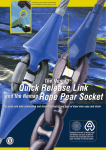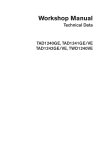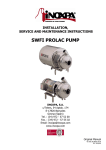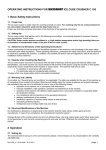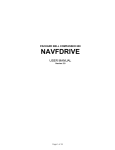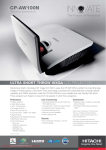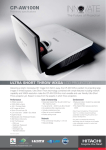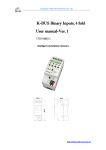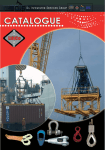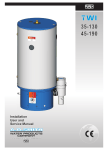Download USER MANUAL
Transcript
USER MANUAL ROPE PEAR SOCKETS SIZE: 1 - 17 A PRODUCT OF NEMAG HOLLAND 1. INTRODUCTION 1.1 1.2 1.3 1.4 1.5 2. DESCRIPTION 2.1 2.2 3. Field of application Technical specifications of NEMAG Rope Pear Sockets Technical specifications of the connecting parts Marking Safety regulations NEMAG Rope Pear Sockets The bow The body MOUNTING AND DISMOUNTING 3.1 3.2 3.3 Casting method NEMAG Rope Pear Sockets to steel wire ropes Removing of metallic casting masses Extruding of synthetic resin casting masses 4. TRANSPORT AND STORAGE 5. MAINTENANCE AND INSPECTION 5.1 5.2 5.3 5.4 5.5 5.6 Lubrication Cleaning Inspection Magnetism Sharp hard points and burrs Test load 6. REJECTION 7. CIRCUMSTANCES BEYOND OUR CONTROL 8. KEY WORDS REGISTER 9. ENCLOSURES 9.1 9.2 Tables Figures Zierikzee, 2002 Additional user manuals can be ordered from: NEMAG B.V. P.O.Box 110/NL-4300 AC Zierikzee / Holland Tel.: 00 31 111 – 41 89 00 / Fax 00 31 111 – 41 61 54 e-mail : [email protected] / www nemag.com 2 1. INTRODUCTION The NEMAG Rope Pear Socket, made of high-alloy austenitic manganese steel, is a common end connection for steel wire ropes. 1.1 The field of application The NEMAG Rope Pear Socket is cast as an end connection to a steel wire rope when: 1.1.1 The complete rope connection, consisting of two NEMAG Rope Pear Sockets and a Quick Release Link, which must run over special (wide U) sheaves, see figure 9.2.1. 1.1.2 The rope connection mentioned in 1.1.1 is used to be able to connect and disconnect two steel wire ropes quickly. 1.1.3 A smooth transition from a steel wire rope to a chain is required, which can be attached or detached quickly (see figure 9.2.2) 1.1.4 A smooth transition from a steel wire rope to an appliance is required, which can be attached or detached quickly (see figure 9.2.3). 1.2 The technical specifications of the NEMAG Rope Pear Socket (table 9.1.1) 1.2.1 Working load The working load is maximally equal to 1/5 of the indicated minimum breaking load. 1.2.2 The breaking load is related to the average applicable steel wire rope in the construction 6x36WS with steel core, with a tensile strength of 1770 N/mm2. 1.2.3 Material NEMAG Rope Pear Sockets are cast out of GX 120 Mn 12, an austenitic manganese steel, with a high elongation. 1.3 Technical specifications of the connecting parts 1.3.1 Dimensions of NEMAG Quick Release links (see table 9.1.2). 1.3.2 Connecting options between various sizes of NEMAG Rope Pear Sockets and Quick Release links (see table 9.1.3). 1.3.3 Dimensions of special sheaves, named 'wide U sheaves' (see table 9.1.4). 1.4 Marking NEMAG Rope Pear Sockets are marked with : 1.4.1 Factory brand 1.4.2 Indication of the size 1.4.3 The batch code 3 1.5 Safety regulations NEMAG Rope Pear Socket 1.5.1 Never expose the NEMAG Rope Pear Socket to a temperature upwards of 350 deg. C. 1.5.2 Do not expose the NEMAG Rope Pear Socket to a temperature of 300° C for more than 100 hours. 1.5.3 Never do any welding work on the NEMAG Rope Pear Socket. 1.5.4 Carry out a visual inspection on the NEMAG Rope Pear Socket for deficiencies after each period of use of 200 hours. 1.5.5 Do not use the NEMAG Rope Pear Socket anymore in case of a permanent deformation. 1.5.6 Do not use the NEMAG Rope Pear Socket if it is strongly magnetic (see par. 5.4). 1.5.7 Do not use the NEMAG Rope Pear Socket anymore if it has undergone more than 250,000 loads. 1.5.8 Never apply a steel wire rope with a diameter that deviates from that stated in table 9.1.1. 1.5.9 Do not use the NEMAG Rope Pear Socket anymore after being overloaded. 1.5.10 Do not use the NEMAG Rope Pear Socket in the event of a greater wear than stated in chapter 6 "REJECTION". 1.5.11 Seriously damaged NEMAG Rope Pear Sockets must not be used. 1.5.12 The melting point of the casting alloy should not exceed 245 deg. C. 1.5.13 NEMAG Rope Pear Sockets must not be heat-treated. 1.5.14 NEMAG Rope Pear Sockets must not be refined again. 1.5.15 NEMAG Rope Pear Sockets cast-on with synthetic resin must not be subjected to temperatures exceeding 115° C. 1.5.16 NEMAG Rope Pear Sockets cast-on with synthetic resin must not be subjected to strong alkalic solutions, acetone and methyl-ethyl ketone. 1.5.17 If you have any doubts about the condition of use of the NEMAG Rope Pear Socket, send a written request for instructions to the manufacturer. 1.5.18 If you have any doubts about the applicability of a NEMAG Rope Pear Socket, send a written request for instructions to the manufacturer. 2. DESCRIPTION (see figure 9.2.4) The NEMAG Rope Pear Socket can be divided into two parts, i.e. the bow and the body. 2.1 The bow The inside of the bow must be smooth and not have any burrs. Possible porosity should not exceed the standard for a penetrant check PT70-2 class 3. 2.2 The body The body is allowed to have a rough area and the porosity lies within class 4 of the standard for a penetrant check PT70-2. In the body there are 2 'level cams' which indicate the maximum casting height. At the bottom of the body, i.e. there where the wire rope is put into the body of the NEMAG Rope Pear Socket, the surface on the inside must be smooth and end in a radius of approx. half the wall thickness. 4 3. MOUNTING AND DISMOUNTING 3.1 Casting method NEMAG Rope Pear Sockets to steel wire ropes This instruction is only general. For a detailed procedure follow the instructions of the suppliers of the casting mass. 3.1.1 The temporary tieing off material (see figure 9.2.5). With wire ropes and strands which are not preformed it is necessary to apply temporary tieing off material on both sides of the cutting point. 3.1.2 Cutting the steel wire rope. Preferably cut through slitting. Do not apply autogenous burning-through for the following reasons: 3.1.2.1Decreased tensile strength of the steel wire rope. 3.1.2.2. Degreasing of the steel wire outside the NEMAG Rope Pear Socket. 3.1.2.3 Wires are difficult to separate when forming a 'broom'. 3.1.3 The permanent tieing-off material (see figure 9.2.5) The permanent tieing-off material has a length of at least 2 x the steel wire diameter. Usually the tieing-off material is tin-plated or made of galvanised soft wire. The total diameter at the tieing-off should not exceed the diameter of the hole on the bottom of the NEMAG Rope Pear Socket. 3.1.4 Dimension 'L' (see figure 9.2.5). 3.1.4.1 Dimension 'L' with the casting masses of synthetic resin or Tego VG3 : L = length conical body of the NEMAG Rope Pear Socket steel wire diameter. 3.1.4.2Dimension 'L' with tin-lead-bismuth alloys and with a few special steel wire connections: L = 1.5 x the length of the conical sleeve of the NEMAG Rope Pear Socket - the steel wire diameter (hereby the wires of the broom are bent back). 3.1.5 The broom (see figure 9.2.6) The steel wire rope is slidden into the degreased NEMAG Rope Pear Socket with or without temporary tieing-off material, and the strands are bent out to the permanent rounding material. The wires of the strands are unwrapped, but not stretched out. Now a broom has been formed with a maximum angle of inclination of 60° C for closed steel wire ropes and a maximum angle of inclination of 45° C for wrought steel wire ropes. Rope or synthetic cores should be cut off up to the permanent tieing-off material. In order to clean, degrease or stain the open broom, it must be held downwards in the degreasant or mordant up to the permanent rounding material. In other words, take care that only the broom and not the steel wire rope is degreased or stained. Cleansing agents, degreasants and mordants must be applied in conformity with the instructions of the supplier of the casting mass. 5 3.1.6 Tin-plating When applying metallic casting masses such as tin-lead-bismuth alloys and Tego VG3, the stained broom is immersed up to the tieing-off material in a tin plating solution of 280 to 300° C, as a result of which all wires should be covered with a thin layer of tin. 3.1.7 Placing and setting up of broom, steel wire rope and NEMAG Rope Pear Socket (see figure 9.2.7). The broom is pulled into the conical case of the NEMAG Rope Pear Socket until: 3.1.7.1The wire ends or the bend of the bent wires lie 1 to 2 mm above the level cam, that is with synthetic resin. 3.1.7.2The wire ends or the bend of the bent wires lie 2 to 5 mm below the level cam, that is with metallic casting masses. The wires at the top of the broom must be divided as much as possible in the conical case. The longitudinal axis of the NEMAG Rope Pear Socket placed at right angles and the heart of the steel wire rope must be in line, and the steel wire rope must run straight from the rope end at least 30 x the length of the rope diameter. The rope end must be sealed with plaster and place it in such a way that is immovable. 3.1.8 Preparing and casting the casting mass. Follow the instructions of the supplier of the casting mass consistently. With metallic casting masses the NEMAG Rope Pear Socket must be preheated. Check local preheating of the NEMAG Rope Pear Socket, for example use a ring-type burner. The preheating temperature depends on the applied casting mass, but should never exceed 200° C. 3.2 Removing of metallic casting masses The melting down of the remaining steel wire end should be done with care. Use a ring-type burner for an equal heating of the NEMAG Rope Pear Socket. However, a well-adjustable electric stove or a thermostatically controlled metal bath is preferable. For melting down the metallic casting alloys, the instructions of the supplier must be followed consistently. Use thermocouples, infrared temperature measuring, contact temperature measuring devices or thermochrome pins for monitoring the temperature. 3.3 Extruding of synthetic resin casting masses The remaining steel wire end in the NEMAG Rope Pear Socket cast with synthetic resin can be pressed out and crushed with a hydraulic press (see figure 9.2.8) 6 4. TRANSPORT AND STORAGE The NEMAG Rope Pear Socket has been conserved for shipment with a rust-proof agent. Take care that the consignment does not come into contact with substances that stimulate oxidation. Minimum storage requirement: under a covering. 5. MAINTENANCE AND INSPECTION 5.1 Lubrication Keeping the contact surfaces of the NEMAG Rope Pear Socket and connected Quick Release link well-lubricated has a strong life-extending effect for both. 5.2 Cleaning During use of the NEMAG Rope Pear Socket particles that stimulate wear may become embedded in the lubricant. It is advisable to regularly clean the bow of the NEMAG Rope Pear Socket. 5.3 Inspection The entire NEMAG Rope Pear Socket, including the steel wire casting, must be visually inspected with respect to deficiencies after each period of use of 200 hours. 5.4 Magnetism NEMAG Rope Pear Sockets of good austenitic quality are lightly magnetic. The magnetism of NEMAG Rope Pear Sockets is measured at the place which is indicated at the location which is indicated on figure 9.2.4. Strong magnetism can be compared with the result of a thickness gauge for a coating layer, whereby the read coating layer thickness equals or is smaller than 100 micron. 5.5 Sharp hard points and burrs Grind off sharp hard points (so-called nitride pins) and burrs which developed as a result of wear. Even polishing the contact surfaces increases the life of the connection. 5.6 Test load NEMAG Rope Pear Sockets can be test-loaded in our workshop on a calibrated tensile testing machine on 2/5 of the minimum breaking load. 6. REJECTION 6.1 Maximum wear on bow. If the wear resulting from use exceeds 15% of the nominal dimensions at any given place, the NEMAG Rope Pear Socket has to be rejected and destroyed. 6.2 Heating of the NEMAG Rope Pear Socket has exceeded 350° C. The NEMAG Rope Pear Socket has to be rejected and destroyed. 6.3 NEMAG Rope Pear Socket is magnetic. The NEMAG Rope Pear Socket is equally or more strongly magnetic than the standard indicated in 5.4. Refining a second time is not possible, it must be rejected and destroyed. 7 6.4 Welding work on the NEMAG Rope Pear Socket. If welding has taken place, the NEMAG Rope Pear Socket has to be rejected and destroyed. 6.5 NEMAG Rope Pear Socket is permanently deformed. These NEMAG Rope Pear Sockets have to be rejected and destroyed. 6.6 Cracks in the material These NEMAG Rope Pear Sockets have to be rejected and destroyed. 6.7 Rope pear has undergone over 250,000 loads These NEMAG Rope Pear Sockets have to be rejected and destroyed. 6.8 NEMAG Rope Pear Socket has worn rope end NEMAG Rope Pear Sockets with a diameter of the rope end that is larger than 105% of size E (see table 9.1) have to be rejected and destroyed. 6.9 Damaged NEMAG Rope Pear Sockets These NEMAG Rope Pear Sockets have to be rejected and destroyed. 6.10 Overloaded NEMAG Rope Pear Socket These NEMAG Rope Pear Sockets have to be rejected and destroyed. 7. CIRCUMSTANCES BEYOND OUR CONTROL The NEMAG Rope Pear Sockets are checked by Nemag. Despite all precautionary measures which are mentioned in this user manual, it is possible that certain causes, which are unknown to us, may result in a failure of our product. In such situations Nemag may consider these cases as circumstances beyond their control, but it will not refrain from doing its utmost best to realise the very best quality. 8 8. KEY WORDS REGISTER page Alkalic solutions ................................................................................................................................................... 4 Austenitic............................................................................................................................................................ 3,7 Batch code ........................................................................................................................................................... 3 Bow .................................................................................................................................................................... 4,7 Brand .................................................................................................................................................................... 3 Breaking load .................................................................................................................................................... 3,7 Broom ................................................................................................................................................................ 5,6 Burrs ............................................................................................................................................................... 2,4,7 Case .................................................................................................................................................................. 4,6 Casting method ................................................................................................................................................. 2,5 Circumstances beyond our control .................................................................................................................. 2,8 Connecting options............................................................................................................................................... 3 Cracks .................................................................................................................................................................. 8 Deforming .......................................................................................................................................................... 4,8 Dimensions of the specifications ......................................................................................................................... 3 End connection .................................................................................................................................................... 3 Field of application ............................................................................................................................................... 3 Heat treatment ..................................................................................................................................................... 4 Information ........................................................................................................................................................... 3 Inspection ....................................................................................................................................................... 2,4,7 Instruction ....................................................................................................................................................... 4,5,6 Level cam ............................................................................................................................................................. 6 Level cams ........................................................................................................................................................... 4 Lubricant .............................................................................................................................................................. 7 Lubrication ......................................................................................................................................................... 2,7 Magnetic ............................................................................................................................................................ 4,7 Magnetism ........................................................................................................................................................ 2,7 Maintenance ..................................................................................................................................................... 2,8 Manganese steel .............................................................................................................................................. 3,7 Material ................................................................................................................................................................. 3 Melting out ......................................................................................................................................................... 4,6 Nitride pins ........................................................................................................................................................... 7 Overload ............................................................................................................................................................ 4,8 Plaster .................................................................................................................................................................. 6 Porosity ................................................................................................................................................................ 4 Preheating temperature ....................................................................................................................................... 6 Refining ................................................................................................................................................................ 4 Refining again ...................................................................................................................................................... 4 Rejection .............................................................................................................................................................. 8 Rope connection .................................................................................................................................................. 3 Rope or synthetic cores ....................................................................................................................................... 5 Rope end ........................................................................................................................................................... 6,8 Rope sheaves ...................................................................................................................................................... 3 Safety regulations ................................................................................................................................................ 4 Specifications ....................................................................................................................................................... 3 Storage ................................................................................................................................................................. 7 Tensile testing machine ....................................................................................................................................... 7 Testing .................................................................................................................................................................. 2 Test loading .......................................................................................................................................................... 7 Tieing-off material ................................................................................................................................................ 5 Welding ............................................................................................................................................................. 4,8 Work load ............................................................................................................................................................. 3 9 9. ENCLOSURES 9.1 Tables 9.1.1 Technical specifications NEMAG Rope Pear Sockets. 9.1.2 Technical specifications Nemag Quick Release Links. 9.1.3 Connecting options between NEMAG Rope Pear Sockets and Nemag Quick Release Links. 9.1.4 Dimensions wide 'U' sheaves. 9.2 Figures 9.2.1 Complete connection and schematic location on rope sheave. 9.2.2 Transition steel rope on chain. 9.2.3 Transition steel rope to appliance. 9.2.4 Names of parts of NEMAG Rope Pear Sockets. 9.2.5 Temporary and permanent tieing-off material on steel wire rope. 9.2.6 Broom on steel wire rope. 9.2.7 Placing and setting up of broom, steel wire rope and NEMAG Rope Pear Sockets. 9.2.8 Hydraulic press for pressing out steel wire end. 10 Technical specifications NEMAG Quick Release Links & NEMAG Rope Pear Sockets * = Working load is max. working load for grabbing operations. For other operations apply the min. safety factor 5. Table 9.1.1 – 9.1.2 11 NEMAG Quick Release Link number NEMAG Rope Pear Socket Number Connection is possible Connection is impossible Connecting options between NEMAG Rope Pear Sockets and Nemag Quick Release Links. Table 9.1.3 12 Dimensions wide 'U' sheaves Diameter C has been designed for a NEMAG Quick Release Link that is one size larger than the NEMAG Rope Pear Socket, in accordance with table. Radius E depends on the applied steel wire diameter. Table 9.1.4 13 Figure 9.2.1 14 Figure 9.2.2 Figure 9.2.3 15 Bow Measuring point magnetism Level cam for casting Case Outer end of NEMAG Rope Pear Socket Figure 9.2.4 Temporary Tieing-off material Figure 9.2.5 Permanent Tieing-off material 9.2.6 Broom 9.2.7 16 Figure 9.2.8 Frontal view Figure 9.2.9 Side view 17 INFORMATION: NEMAG B.V. P.O.Box 110 NL-4300 AC Zierikzee - Holland Tel. Fax e-mail www : 00 31 111 – 41 89 00 : 00 31 111 – 41 61 54 : [email protected] : nemag.com 18 1



















